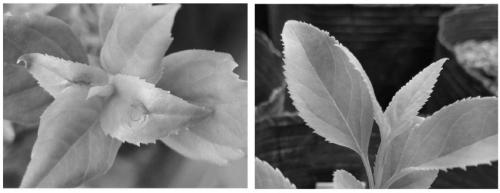Method for mediating virus-induced gene silencing by TRV vectors in forsythia suspensa leaf
A carrier, forsythia technology, applied in the field of genetic engineering, can solve the problems of restricting the molecular biology research of forsythia, and there is no efficient gene function verification method.
- Summary
- Abstract
- Description
- Claims
- Application Information
AI Technical Summary
Problems solved by technology
Method used
Image
Examples
Embodiment 1
[0028] 1. Acquisition of experimental materials: Potted forsythia cutting seedlings were taken, re-cut and placed in an artificial climate chamber for cultivation, and set aside. Culture conditions: light 300μmol·m -2 ·s -1 , 16h, 22°C, dark 8h, 18°C, humidity 60%.
[0029] 2. Recombinant vector construction: The amplified Forsythia phytoene dehydrogenase (hereinafter referred to as: FsPDS) gene fragment was connected to the TRV virus-induced gene silencing vector pTRV2 by the method of genetic engineering to obtain the recombinant pTRV- FsPDS. Specific steps are as follows:
[0030] Preparation of cDNA: Extract the total mRNA of Forsythia leaves according to the Trizol method, perform reverse transcription of the total mRNA according to the operation instructions of the Tiangen Reverse Transcription Kit, obtain Forsythia cDNA, dilute 20 times, and store at -20°C for later use.
[0031] Amplification of Forsythia PDS gene fragment (FsPDS):
[0032] PCR primers were design...
PUM
 Login to View More
Login to View More Abstract
Description
Claims
Application Information
 Login to View More
Login to View More - R&D
- Intellectual Property
- Life Sciences
- Materials
- Tech Scout
- Unparalleled Data Quality
- Higher Quality Content
- 60% Fewer Hallucinations
Browse by: Latest US Patents, China's latest patents, Technical Efficacy Thesaurus, Application Domain, Technology Topic, Popular Technical Reports.
© 2025 PatSnap. All rights reserved.Legal|Privacy policy|Modern Slavery Act Transparency Statement|Sitemap|About US| Contact US: help@patsnap.com



